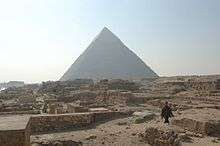Necropolis
A necropolis is a large ancient cemetery with elaborate tomb monuments. Ancient Greek νεκρόπολις nekropolis, literally meaning "city of the dead". The term implies a separate burial site at a distance from a city as opposed to tombs within cities, which were common in various places and periods of history. They are different from grave fields, which did not have remains above the ground. While the word is most commonly used for ancient sites, it has also been used for some modern cemeteries such as the Glasgow Necropolis.
History

The Giza Necropolis of ancient Egypt is one of the oldest and probably the most well-known necropolis in the world since the Great Pyramid of Giza was included in the Seven Wonders of the Ancient World. Aside from the pyramids which were reserved for the burial of Pharaohs the Egyptian necropoleis included mastabas, a typical royal tomb of the early Dynastic period.

Naqsh-e Rustam is an ancient necropolis located about 12 km northwest of Persepolis, in Fars Province, Iran. The oldest relief at Naqsh-i Rustam dates to c. 1000 BC. Though it is severely damaged, it depicts a faint image of a man with unusual head-gear and is thought to be Elamite in origin. The depiction is part of a larger image, most of which was removed at the command of Bahram II. Four tombs belonging to Achaemenid kings are carved out of the rock face at a considerable height above the ground. The tombs are known locally as the 'Persian crosses', after the shape of the facades of the tombs. Later, Sassanian kings added a series of rock reliefs below the tombs.
In the Mycenean Greek period pre-dating ancient Greece burials could be performed inside the city. In Mycenae for example the royal tombs were located in a precinct within the city walls. This changed during the ancient Greek period when necropoleis usually lined the roads outside a city. There existed some degree of variation within the ancient Greek world however. Sparta was notable for continuing the practice of burial within the city.[1]
The Etruscans took the concept of a "city of the dead" quite literally. The typical tomb at the Banditaccia necropolis at Cerveteri consists of a tumulus which covers one or more rock-cut subterranean tombs. These tombs had multiple chambers and were elaborately decorated like contemporary houses. The arrangement of the tumuli in a grid of streets gave it an appearance similar to the cities of the living.[2] The art historian Nigel Spivey considers the name cemetery inadequate and argues that only the term necropolis can do justice to these sophisticated burial sites.[3][4] Etruscan necropoleis were usually located on hills or slopes of hills.[5]
In ancient Rome families originally buried deceased relatives in their own homes because of the Roman practice of ancestor worship. The enactment of the Twelve Tables in 449 BC forbade this, which made the Romans adopt the practice of burial in necropoleis.[6]
References
- ↑ Erasmo, Mario (2012). Death: Antiquity and Its Legacy. London: I.B. Tauris. p. 74. ISBN 9781848855571.
- ↑ Gardner, Helen; Kleiner, Fred S. (2010). Gardner's Art Through the Ages: The Western Perspective. Boston, MA: Cengage Learning. p. 148. ISBN 9780495573555.
- ↑ Worpole, Ken (2003). Last Landscapes: The Architecture of the Cemetery in the West. London: Reaktion Books. pp. 79–84. ISBN 9781861891617.
- ↑ Spivey, Nigel; Squire, Michael (2004). Panorama of the Classical World. London: Thames & Hudson Ltd. p. 17. ISBN 9781606060568.
- ↑ Erasmo, Mario (2012). Death: Antiquity and Its Legacy. London: I.B. Tauris. pp. 76–77. ISBN 9781848855571.
- ↑ Kyle, Donald G. (1998). Spectacles of Death in Ancient Rome. London: Routledge. p. 145. ISBN 9781134862719.
DSCF6681.jpg)